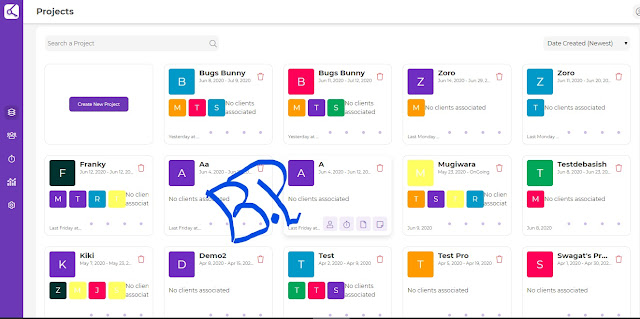What Is Cloud Computing?
What is the cloud? Where is the cloud? Are we in the cloud now? These are all questions you've probably heard or even asked yourself. The term "cloud computing" is everywhere.
In the simplest terms, cloud computing means storing and accessing data and programs over the Internet instead of your computer's hard drive. The cloud is just a metaphor for the Internet. It goes back to the days of flowcharts and presentations that would represent the gigantic server-farm infrastructure of the Internet as nothing but a puffy, white cumulus cloud, accepting connections and doling out information as it floats.
What cloud computing is not about is your hard drive. When you store data on or run programs from the hard drive, that's called local storage and computing. Everything you need is physically close to you, which means accessing your data is fast and easy, for that one computer, or others on the local network. Working off your hard drive is how the computer industry functioned for decades; some would argue it's still superior to cloud computing, for reasons I'll explain shortly.
The cloud is also not about having a dedicated network attached storage (NAS) hardware or server in residence. Storing data on a home or office network does not count as utilizing the cloud. (However, some NAS will let you remotely access things over the Internet, and there's at least one brand from Western Digital named "My Cloud," just to keep things confusing.)
For it to be considered "cloud computing," you need to access your data or your programs over the Internet, or at the very least, have that data synced with other information over the Web. In a big business, you may know all there is to know about what's on the other side of the connection; as an individual user, you may never have any idea what kind of massive data processing is happening on the other end. The end result is the same: with an online connection, cloud computing can be done anywhere, anytime.
Consumer vs. Business
Let's be clear here. We're talking about cloud computing as it impacts individual consumers—those of us who sit back at home or in small-to-medium offices and use the Internet on a regular basis.
There is an entirely different "cloud" when it comes to business. Some businesses choose to implement Software-as-a-Service (SaaS), where the business subscribes to an application it accesses over the Internet. (Think Salesforce.com.) There's also Platform-as-a-Service (PaaS), where a business can create its own custom applications for use by all in the company. And don't forget the mighty Infrastructure-as-a-Service (IaaS), where players like Amazon, Microsoft, Google, and Rackspace provide a backbone that can be "rented out" by other companies. (For example, Netflix provides services to you because it's a customer of the cloud services at Amazon.)
Of course, cloud computing is big business: The market generated $100 billion a year in 2012, which could be $127 billion by 2017 and $500 billion by 2020.
Common Cloud Examples
The lines between local computing and cloud computing sometimes get very, very blurry. That's because the cloud is part of almost everything on our computers these days. You can easily have a local piece of software (for instance, Microsoft Office 365) that utilizes a form of cloud computing for storage (Microsoft OneDrive).
That said, Microsoft also offers a set of Web-based apps, Office Online, that are Internet-only versions of Word, Excel, PowerPoint, and OneNote accessed via your Web browser without installing anything. That makes them a version of cloud computing (Web-based=cloud).
Google Drive: This is a pure cloud computing service, with all the storage found online so it can work with the cloud apps: Google Docs, Google Sheets, and Google Slides. Drive is also available on more than just desktop computers; you can use it on tablets like the iPad or on smartphones, and there are separate apps for Docs and Sheets, as well. In fact, most of Google's services could be considered cloud computing: Gmail, Google Calendar, Google Maps, and so on.
Apple iCloud: Apple's cloud service is primarily used for online storage, backup, and synchronization of your mail, contacts, calendar, and more. All the data you need is available to you on your iOS, Mac OS, or Windows device (Windows users have to install the iCloud control panel). Naturally, Apple won't be outdone by rivals: it offers cloud-based versions of its word processor (Pages), spreadsheet (Numbers), and presentations (Keynote) for use by any iCloud subscriber. iCloud is also the place iPhone users go to utilize the Find My iPhone feature that's all important when the handset goes missing.
Amazon Cloud Drive: Storage at the big retailer is mainly for music, preferably MP3s that you purchase from Amazon, and images—if you have Amazon Prime, you get unlimited image storage. Amazon Cloud Drive also holds anything you buy for the Kindle. It's essentially storage for anything digital you'd buy from Amazon, baked into all its products and services.
Hybrid services like Box, Dropbox, and SugarSync all say they work in the cloud because they store a synced version of your files online, but they also sync those files with local storage. Synchronization is a cornerstone of the cloud computing experience, even if you do access the file locally.
Likewise, it's considered cloud computing if you have a community of people with separate devices that need the same data synced, be it for work collaboration projects or just to keep the family in sync. For more, check out the The Best Cloud Storage and File-Syncing Services for 2016.



Comments
Post a Comment